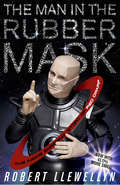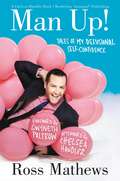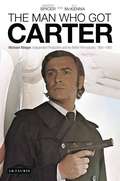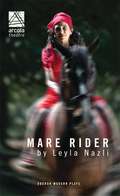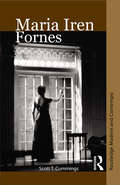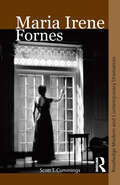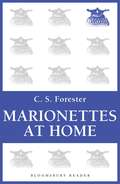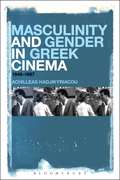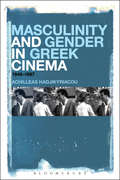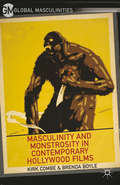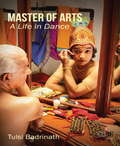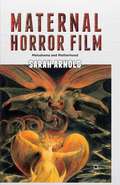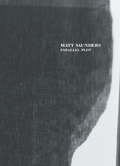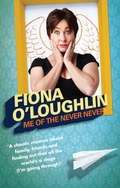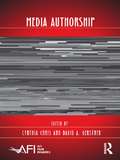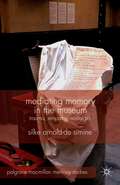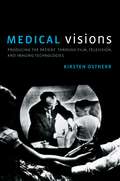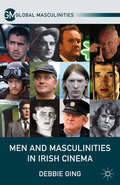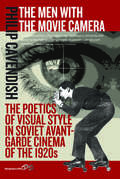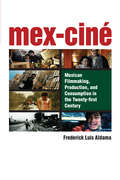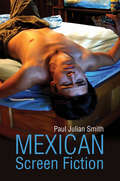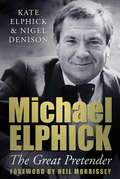- Table View
- List View
The Man In The Rubber Mask: The Inside Smegging Story of Red Dwarf
by Robert LlewellynIt was 1989 when Robert Llewellyn first had his head encased in the one-piece latex foam-rubber balaclava that is the head of Kryten in Red Dwarf series three, and it gave him a distinctly funny turn.Gazing at his own reflection and seeing the face of a mechanoid robot staring back was surprisingly scary, not to mention uncomfortable and rather sweaty. And he couldn't even eat his lunch.Since then, he has sweated, frozen, been set on fire, exploded, spent thousands of hours in the make-up chair and thousands more being taunted by Craig Charles for being a middle-class b*****d. So it is a testament to the joyful camaraderie and life-enhancing silliness of the world of Red Dwarf that twenty-three years later, Robert is still willing to risk life, limb and hairline to don the rubber torture helmet for Red Dwarf X, the recent triumphant return of the motley band of space bums.Originally published in 1993 after series six, The Man in the Rubber Mask has now been completely updated with 43.7% extra smeg.
Man Up!: Tales of My Delusional Self-Confidence (A Chelsea Handler Book/Borderline Amazing Publishing)
by Ross MathewsIn this hilarious and inspirational memoir, Ross Mathews-best known as "Ross the Intern" from The Tonight Show with Jay Leno-chronicles his life growing up as an atypical kid in a small Northwestern farm town to living as an atypical adult in Los Angeles, to eventually being his loud, proud, apologetically genuine self on national television.As a young kid growing up in a farm town, Ross Mathews might as well have wished for a pet unicorn or a calorie-free cookie tree to grow in his front yard. Either of those far-fetched fantasies would have been more likely to come true than his real dream: working in television in Hollywood, California. Seriously, that stuff just doesn't happen to people like Ross. But guess what? It totally did.Now, with his first book, Ross takes us inside his journey as a super-fan, revealing the most embarrassing and hilarious moments of his small-town life and big-city adventures. From learning to swear like a hardened trucker to that time in high school when had to face down the most frightening opponent of all (his girlfriend's lady bits), Ross holds nothing back. Oh, then there's his surprisingly shady past involving the cutest pair of plus-sized women's pajama bottoms, deliciously dangerous pot butter, and embezzled sandwiches. And, of course, how he's managed to turn an obsession with pop-culture into one-on-one interactions with celebrities like Gwyneth Paltrow, Tiffani-Amber Theissen, Madonna, Michelle Kwan, and countless more without ever having a single restraining order issued against him.Infused with Ross's trademark humor, unique voice, and total honesty, Man Up! is a mission statement for anyone who doesn't fit the mold. His hasn't been the most traditional way to build a career in Hollywood, but Ross has somehow managed to make his mark without ever compromising who he is. He is as serious about this as he is about Golden Girls trivia: You don't need to change who you are to achieve your dreams (although there's nothing wrong with a makeover every now and then). You just need to Man Up!
The Man Who Got Carter: Michael Klinger, Independent Production and the British Film Industry, 1960-1980 (International Library Of The Moving Image Ser.)
by Andrew Spicer A.T. McKenna A. T. McKennaMichael Klinger was the most successful independent producer in the British film industry over a twenty year period, from 1960 to 1980, responsible for 32 films, including classics such as Repulsion and Get Carter. Despite working with many famous figures, including Michael Caine, Claude Chabrol, Mike Hodges, Lee Marvin and Roman Polanski, Klinger's contribution to British cinema has been ignored.This definitive book on Klinger, largely based on his previously unseen personal papers, examines his origins in the Sixties' Soho sex industry, sexploitation cinema and 'shockumentaries', through to major international productions, including Shout at the Devil. It reveals how Klinger deftly combined commercial product – the popular 'Confessions' series – with artistic, experimental cinema and highlights the importance of his Jewishness. The book also assesses the essential, often misunderstood role played by the producer.
Mare Rider (Oberon Modern Plays)
by Leyla NazliElka is the sinister Mare Rider, in myth she haunts new mothers and rides bareback through mountains and across the plains of Anatolia. Selma is about to give birth at Homerton Hospital in Hackney, Elka takes her on a fantastical journey, probing the spaces between Selma's nightmarish visions and the reality of those around her.
Maria Irene Fornes (Routledge Modern and Contemporary Dramatists)
by Scott T. CummingsMaria Irene Fornes is the most influential female American dramatist of the 20th century. That is the argument of this important new study, the first to assess Fornes's complete body of work. Scott T. Cummings considers comic sketches, opera libretti and unpublished pieces, as well as her best-known plays, in order to trace the evolution of her dramaturgy from the whimsical Off-Off Broadway plays of the 1960s to the sober, meditative work of the 1990s. The book also reflects on her practice as an inspirational teacher of playwriting and the primary director of her own plays. Drawing on the latest scholarship and his own personal research and interviews with Fornes over two decades, Cummings examines Fornes's unique significance and outlines strategies for understanding her fragmentary, enigmatic, highly demanding theater.
Maria Irene Fornes (Routledge Modern and Contemporary Dramatists)
by Scott T. CummingsMaria Irene Fornes is the most influential female American dramatist of the 20th century. That is the argument of this important new study, the first to assess Fornes's complete body of work. Scott T. Cummings considers comic sketches, opera libretti and unpublished pieces, as well as her best-known plays, in order to trace the evolution of her dramaturgy from the whimsical Off-Off Broadway plays of the 1960s to the sober, meditative work of the 1990s. The book also reflects on her practice as an inspirational teacher of playwriting and the primary director of her own plays. Drawing on the latest scholarship and his own personal research and interviews with Fornes over two decades, Cummings examines Fornes's unique significance and outlines strategies for understanding her fragmentary, enigmatic, highly demanding theater.
Marionettes at Home
by C. S. ForesterInspired by a marionette show he saw, C.S. Forester, a novelist and theatre lover, decided to create his own puppet theatre at home. In Marionettes at Home, first published in 1936, he shares his experience and enthusiasm for amateur puppeteering and takes the reader step-by-step through the stages of creating one's own theatre; from stage construction and puppet making, to acting and production. Written with passion and sense of humour Marionettes at Home is a little gem that anyone interested in the theatre and puppeteering history would enjoy.
Masculinity and Gender in Greek Cinema: 1949-1967
by Achilleas HadjikyriacouBetween the end of the Civil War (1949) and the colonels' military coup (1967) Greece underwent tremendous political, economic, and social transformations which influenced gender identities and relations. During the same period, Greece also witnessed an unparalleled bloom in cinema productions. Based on the recently established paradigm that cinema and popular culture viewed as social institutions can inform a historical study, Masculinity and Gender in Greek Cinema explores the relationship between Greek cinema and the society within which it was created and viewed. The book's double analytical perspective on cinema and masculinity advances both the study of cinema and popular culture as historical sources, and of masculinity and gender relations as valid categories of historical analysis. Cinema as a medium of representation, not only managed to reflect on these issues, it also provided a whole new field for their interpretation. This is the first study to explore the dramatic transformation of masculinity and gender roles, as represented in Greek cinema during the turbulent 1950s and 1960s.
Masculinity and Gender in Greek Cinema: 1949-1967
by Achilleas HadjikyriacouBetween the end of the Civil War (1949) and the colonels' military coup (1967) Greece underwent tremendous political, economic, and social transformations which influenced gender identities and relations. During the same period, Greece also witnessed an unparalleled bloom in cinema productions. Based on the recently established paradigm that cinema and popular culture viewed as social institutions can inform a historical study, Masculinity and Gender in Greek Cinema explores the relationship between Greek cinema and the society within which it was created and viewed. The book's double analytical perspective on cinema and masculinity advances both the study of cinema and popular culture as historical sources, and of masculinity and gender relations as valid categories of historical analysis. Cinema as a medium of representation, not only managed to reflect on these issues, it also provided a whole new field for their interpretation. This is the first study to explore the dramatic transformation of masculinity and gender roles, as represented in Greek cinema during the turbulent 1950s and 1960s.
Masculinity and Monstrosity in Contemporary Hollywood Films (Global Masculinities)
by K. Combe B. BoyleIn film, Men are good and Monsters are bad. In this book, Combe and Boyle consider the monstrous body as a metaphor for the cultural body and regard gendered behavior as a matter of performativity. Taken together, these two identity positions, manliness and monsterliness, offer a window into the workings of current American society.
Master of Arts: A Life in Dance
by Tulsi BadrinathV.P. Dhananjayan was one of the first men to make a successful career as a Bharata Natyam dancer. In the late sixties, when he made this choice, Bharata Natyam – the classic dance form that Rukmini Devi helped evolve from the dance of the devadasis – was almost exclusively the domain of women. In making Bharata Natyam his profession, Dhananjayan had to create a space for his dance where none existed. It is only recently, in the relatively short span of the past seventy years, and to a great extent because of the creative efforts of versatile and innovative dancers like Dhananjayan, that greater number of men have performed Bharata Natyam as men, without needing to dress as women to appear on stage. As Dhananjayan’s student for nearly forty years now, and a trained dancer herself, the author, Tulsi Badrinath, chronicles the story of his brilliant life in dance with the insight of one who understands each nuance of it. Weaving her own life-long passion for Bharata Natyam with his remarkable story, she brings to light the difficulties faced by a male dancer in establishing himself in what was thought to be a somewhat unrespectable profession, and tells the compelling story of his life with empathy and understanding. Writing of his years in Kalakshetra and his departure from it; of the deep love that blossomed between him and his wife, Shanta, and the incredible dance partnership they forged, making them famous as The Dhananjayans; of his international collaborations with Ravi Shankar; and of his ability, as guru and teacher, to impart his passion for dance to his disciples, she explores her own understanding of what the dance, and her guru, have meant to her. Interspersing this remarkable tale of guru and shishya with the stories of other young male dancers in the realm of Bharata Natyam, she pays tribute to their extraordinary commitment, their talent and their courage.
Maternal Horror Film: Melodrama and Motherhood
by S. ArnoldMaternal Horror Film: Melodrama and Motherhood examines the function of the mother figure in horror film. Using psychoanalytic film theory as well as comparisons with the melodrama film, Arnold investigates the polarized images of monstrous and sacrificing mother.
Matt Saunders: Parallel Plot
by Matt SaundersBerlin-based artist Matt Saunders has in recent years captured the art world’s eye with a striking series of hybrid images and animated films produced using techniques from both photography and painting. Using movie stars such as German actress Hertha Thiele and British actor Patrick McGoohan as subjects, Saunders recasts historical film and television images into new discourses about portraiture, iconography, and spectatorship. Matt Saunders: Parallel Plot is both an artist’s book and a catalog that documents and reflects on a 2010 exhibition held at the Renaissance Society at the University of Chicago. Reproducing the stunning artwork from that show, the book also includes two conversations between Saunders and artist Josiah McElheny and an essay by experimental film scholar Bruce Jenkins that tackles the relationship among painting, photography, and film, as well as the dynamics of Saunders’s iconography. Offering insight into Saunders’s sophisticated working methods, this book is an evocative introduction to the work of this intriguing artist and the intertwined histories of film and photography.
Matt Saunders: Parallel Plot
by Matt SaundersBerlin-based artist Matt Saunders has in recent years captured the art world’s eye with a striking series of hybrid images and animated films produced using techniques from both photography and painting. Using movie stars such as German actress Hertha Thiele and British actor Patrick McGoohan as subjects, Saunders recasts historical film and television images into new discourses about portraiture, iconography, and spectatorship. Matt Saunders: Parallel Plot is both an artist’s book and a catalog that documents and reflects on a 2010 exhibition held at the Renaissance Society at the University of Chicago. Reproducing the stunning artwork from that show, the book also includes two conversations between Saunders and artist Josiah McElheny and an essay by experimental film scholar Bruce Jenkins that tackles the relationship among painting, photography, and film, as well as the dynamics of Saunders’s iconography. Offering insight into Saunders’s sophisticated working methods, this book is an evocative introduction to the work of this intriguing artist and the intertwined histories of film and photography.
Me of the Never Never: The chaotic life and times of Fiona O'Loughlin
by Fiona O'LoughlinNothing turns out as you plan, I guess; but I often think if I'd gone to a fortune teller when I was at school and been told I'd marry a guy who makes false teeth, move to Alice Springs, have five kids and become a standup comedian; well, I would have been surprised to say the least.'Fiona O’Loughlin is certainly the funniest (and possibly one of the busiest) working mothers in Australia today: a stand-up comedian based in Alice Springs and Adelaide, she is on the road for most of the year, doing live performances, plus regular television appearances. Fiona has also had successful shows at the Edinburgh and Adelaide fringe festivals, the Just for Laughs Festival in Montreal and the Melbourne International Comedy Festival.This book contains her stories – funny and sometimes sad – about her upbringing as part of a large Irish-Catholic family on a wheat farm in South Australia, her chaotic and disorganised family life ever since, living in Alice Springs and making it as a stand-up comedian. She also talks of a darker side of the life of many performers – alcohol.This book is for anyone who likes to laugh (and cry), who wants to read about a woman living her life on her terms.‘O‘Loughlin memoir is deep and honest, as she describes her love for her large family and her ordeal of struggling with alcohol addiction’– The NSW Writers Centre‘Her memoir is charm personified in that it’s not only a fascinating journey through an Australian woman’s life, its candour and honesty is kind of heart-melting’- Australian Women Online‘This is one which will raise a lot of laughs not least because she is one of those rare people who can see the funny side to everything life throws at her’ - Weekend Notes
Media Authorship (AFI Film Readers)
by Cynthia Chris David A. GerstnerContemporary media authorship is frequently collaborative, participatory, non-site specific, or quite simply goes unrecognized. In this volume, media and film scholars explore the theoretical debates around authorship, intention, and identity within the rapidly transforming and globalized culture industry of new media. Defining media broadly, across a range of creative artifacts and production cultures—from visual arts to videogames, from textiles to television—contributors consider authoring practices of artists, designers, do-it-yourselfers, media professionals, scholars, and others. Specifically, they ask: What constitutes "media" and "authorship" in a technologically converged, globally conglomerated, multiplatform environment for the production and distribution of content? What can we learn from cinematic and literary models of authorship—and critiques of those models—with regard to authorship not only in television and recorded music, but also interactive media such as videogames and the Internet? How do we conceive of authorship through practices in which users generate content collaboratively or via appropriation? What institutional prerogatives and legal debates around intellectual property rights, fair use, and copyright bear on concepts of authorship in "new media"? By addressing these issues, Media Authorship demonstrates that the concept of authorship as formulated in literary and film studies is reinvigorated, contested, remade—even, reauthored—by new practices in the digital media environment.
Media Authorship (AFI Film Readers)
by Cynthia Chris David A. GerstnerContemporary media authorship is frequently collaborative, participatory, non-site specific, or quite simply goes unrecognized. In this volume, media and film scholars explore the theoretical debates around authorship, intention, and identity within the rapidly transforming and globalized culture industry of new media. Defining media broadly, across a range of creative artifacts and production cultures—from visual arts to videogames, from textiles to television—contributors consider authoring practices of artists, designers, do-it-yourselfers, media professionals, scholars, and others. Specifically, they ask: What constitutes "media" and "authorship" in a technologically converged, globally conglomerated, multiplatform environment for the production and distribution of content? What can we learn from cinematic and literary models of authorship—and critiques of those models—with regard to authorship not only in television and recorded music, but also interactive media such as videogames and the Internet? How do we conceive of authorship through practices in which users generate content collaboratively or via appropriation? What institutional prerogatives and legal debates around intellectual property rights, fair use, and copyright bear on concepts of authorship in "new media"? By addressing these issues, Media Authorship demonstrates that the concept of authorship as formulated in literary and film studies is reinvigorated, contested, remade—even, reauthored—by new practices in the digital media environment.
Mediating Memory in the Museum: Trauma, Empathy, Nostalgia (Palgrave Macmillan Memory Studies)
by S. Arnold-de-Simine Silke Arnold-de SimineMediating Memory in the Museum is a contribution to an emerging field of research that is situated at the interface between memory studies and museum studies. It highlights the role of museums in the proliferation of the so-called memory boom as well as the influence of memory discourses on international trends in museum cultures.
Medical Visions: Producing the Patient Through Film, Television, and Imaging Technologies
by Kirsten OstherrHow do visual images shape the practice of medicine? What role does visual representation play in the cultivation of medical ways of seeing? And how has medicine's visual culture changed in the digital age? Kirsten Ostherr's ambitious study explores 120 years of medical image-making to explain how visual representations shape medical education and practice. Marshaling powerful, vivid examples she demonstrates how medical images created by the healthcare industry, documentary filmmakers, experimental artists, and the mass media acquire cultural meaning and influence doctors' and patients' understandings of health and disease. Her analysis proceeds chronologically, turning from the earliest experiments with medical filmmaking by the American College of Surgeons, to the place of health films in the "golden age" of instructional film in the 1960s. Ostherr considers the shift to television as the dominant medium of health education, highlighting the evolving status of realism, the techniques employed to bridge the entertainment-education divide, the role of expert consultants and sponsors, and the tradeoffs made by professionals to reach a broad audience. The rise of physician advice segments on newsmagazines forms a transition between medical dramas like Marcus Welby, MD and more recent reality shows like Boston Med and Doctor 90210. Concluding with a section on advertising and social media in the health care setting, the book ends with ten key lessons for the future of medical media.
Men and Masculinities in Irish Cinema (Global Masculinities)
by D. GingSpanning a broad trajectory, from the New Gaelic Man of post-independence Ireland to the slick urban gangsters of contemporary productions, this study traces a significant shift from idealistic images of Irish manhood to a much more diverse and gender-politically ambiguous range of male identities on the Irish screen.
The Men with the Movie Camera: The Poetics of Visual Style in Soviet Avant-Garde Cinema of the 1920s
by Philip CavendishUnlike previous studies of the Soviet avant-garde during the silent era, which have regarded the works of the period as manifestations of directorial vision, this study emphasizes the collaborative principle at the heart of avant-garde filmmaking units and draws attention to the crucial role of camera operators in creating the visual style of the films, especially on the poetics of composition and lighting. In the Soviet Union of the 1920s and early 1930s, owing to the fetishization of the camera as an embodiment of modern technology, the cameraman was an iconic figure whose creative contribution was encouraged and respected. Drawing upon the film literature of the period, Philip Cavendish describes the culture of the camera operator, charts developments in the art of camera operation, and studies the mechanics of key director-cameraman partnerships. He offers detailed analysis of Soviet avant-garde films and draws comparisons between the visual aesthetics of these works and the modernist experiments taking place in the other spheres of the visual arts.
Mex-Ciné: Mexican Filmmaking, Production, and Consumption in the Twenty-first Century
by Frederick L AldamaMex-Cinéoffers an accessibly written, multidisciplinary investigation of contemporary Mexican cinema that combines industrial, technical, and sociopolitical analysis with analyses of modes of reception through cognitive theory. Mex-Cinéaims to make visible the twenty-first century Mexican film industry, its blueprints, and the cognitive and emotive faculties involved in making and consuming its corpus. A sustained, free-flowing book-length meditation, Mex-Ciné enriches our understanding of the way contemporary Mexican directors use specific technical devices, structures, and characterizations in making films in ways that guide the perceptual, emotive, and cognitive faculties of their ideal audiences, while providing the historical contexts in which these films are made and consumed.
Mexican Screen Fiction: Between Cinema and Television
by Paul Julian SmithMexican cinema is booming today, a decade after the international successes of Amores perros and Y tu mamá también. Mexican films now display a wider range than any comparable country, from art films to popular genre movies, and boasting internationally renowned directors like Alfonso Cuarón, Alejandro González Iñárritu, and Guillermo del Toro. At the same time, television has broadened its output, moving beyond telenovelas to produce higher-value series and mini-series. Mexican TV now stakes a claim to being the most dynamic and pervasive national narrative. This new book by Paul Julian Smith is the first to examine the flourishing of audiovisual fiction in Mexico since 2000, considering cinema and TV together. It covers much material previously unexplored and engages with emerging themes, including violence, youth culture, and film festivals. The book includes reviews of ten films released between 2001 and 2012 by directors who are both established (Maryse Sistach, Carlos Reygadas) and new (Jorge Michel Grau, Michael Rowe, Paula Markovitch). There is also an appendix that includes interviews carried out by the author in 2012 with five audiovisual professionals: a feature director, a festival director, an exhibitor, a producer, and a TV screenwriter. Mexican Screen Fiction will be an invaluable resource for students and scholars and essential reading for anyone interested in one of the most vibrant audiovisual industries in the world today.
Mexican Screen Fiction: Between Cinema and Television
by Paul Julian SmithMexican cinema is booming today, a decade after the international successes of Amores perros and Y tu mamá también. Mexican films now display a wider range than any comparable country, from art films to popular genre movies, and boasting internationally renowned directors like Alfonso Cuarón, Alejandro González Iñárritu, and Guillermo del Toro. At the same time, television has broadened its output, moving beyond telenovelas to produce higher-value series and mini-series. Mexican TV now stakes a claim to being the most dynamic and pervasive national narrative. This new book by Paul Julian Smith is the first to examine the flourishing of audiovisual fiction in Mexico since 2000, considering cinema and TV together. It covers much material previously unexplored and engages with emerging themes, including violence, youth culture, and film festivals. The book includes reviews of ten films released between 2001 and 2012 by directors who are both established (Maryse Sistach, Carlos Reygadas) and new (Jorge Michel Grau, Michael Rowe, Paula Markovitch). There is also an appendix that includes interviews carried out by the author in 2012 with five audiovisual professionals: a feature director, a festival director, an exhibitor, a producer, and a TV screenwriter. Mexican Screen Fiction will be an invaluable resource for students and scholars and essential reading for anyone interested in one of the most vibrant audiovisual industries in the world today.
Michael Elphick: The Great Pretender
by Kate Elphick Nigel DenisonMichael Elphick was a young electrician working at the Chichester Theatre when he was discovered by Laurence Olivier, who arranged for him to join the Central School of Drama. It was here where he met Bruce Robinson, who would later cast him in one of the most popular British films of all time – Withnail and I. Elphick’s illustrious career also included major supporting roles in films such as Quadrophenia, The Elephant Man, Gorky Park and Dennis Potter’s Blue Remembered Hills. On television, there was Private Schultz and Boon, which gave his acolyte and friend, Neil Morrissey, his first starring role. One of his characters’ owned houses in Coronation Street whilst another wooed Peggy Mitchell in Eastenders. However, Elphick’s private life was every bit as varied as his acting career. Racked by alcoholism and devastated by the early death of his partner, Julia, Elphick died at the age of 55. And yet, his friends and family will always remember his hugely humorous personality, and everyone he met was left with a ‘Mike Elphick story’...
